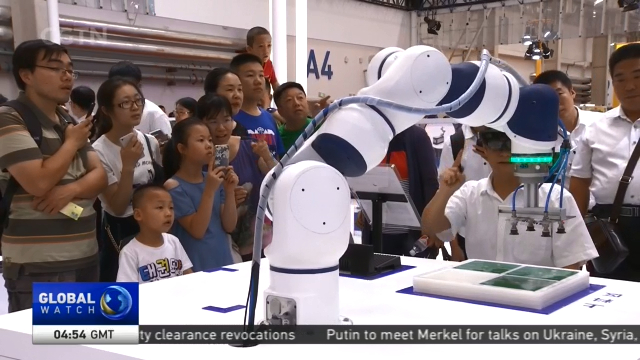
13:10, 18-Aug-2018
World Robot Conference: 'Created-in-China' robots make splash at big global gathering
Updated
13:09, 21-Aug-2018
02:36

The fourth annual World Robot Conference is underway in Beijing. Among the 160 exhibitors from across the globe, those behind "Created-in-China" robots have a considerable presence, giving them a golden opportunity to widen their global impact. Our reporter Wang Mengzhen talked to some of them to hear about their achievements, and what challenges lie ahead.
Still remember the wonderful dance by 24 mobile robots during China's show in the closing ceremony of the Pyeongchang Winter Olympics? The robots were from Siasun, one of China's earliest robot manufacturers based in the northeastern city of Shenyang. Created by a group of scientists in 2000, the firm faced fierce competition in the beginning.
HA ENJING, PR DIRECTOR SIASUN ROBOT & AUTOMATION "In the past, robotic products came from countries that have a history of 100 years in developing the technology. But for Chinese companies, we only spent some 20 years. So, we had to persuade consumers by offering free trial uses of our robots. Step by step, we won their trust."
This is the 4th time Siasun has joined the World Robot Conference in Beijing. Now it is expanding to even smarter products called "Co-bot" or Collaborative Robot. But don't worry about job losses. These robots are meant to better work with human beings in areas like factories and rescue operations.
Tinavi, the country's first robotic surgery-focused company, had some twists and turns until its 3rd-generation robots eventually hit the Chinese market in late 2016.
SUN LANG, BRAND MANAGER TINAVI "Compared with our foreign counterparts, we have strengths in clinical accuracy, and our robots could be widely used in a variety of indications in the orthopedic surgeries. But as a pioneer in the field, we have some difficulties ahead including to get permission from more hospitals and whether to be included in medical insurance."
Global humanoid robot leader UBTECH says it is very proud that all its components and core-tech are created in China…
ZHANG CHENGWEN, VICE PRESIDENT UBTECH ROBOTICS "In the past, the biggest challenge we faced is how to commercialize what used to exist in the lab. The technology has been there for a while, but the most valuable thing we have done is that we've popularized the tech and spread it out to the public."
WANG MENGZHEN BEIJING "For these Chinese robots working in different fields, it's also a very good time for them to get together. That's why some of them have formed a music band to create synergy and momentum for the exciting new era. Wang Mengzhen, CGTN, Beijing.

SITEMAP
Copyright © 2018 CGTN. Beijing ICP prepared NO.16065310-3
Copyright © 2018 CGTN. Beijing ICP prepared NO.16065310-3